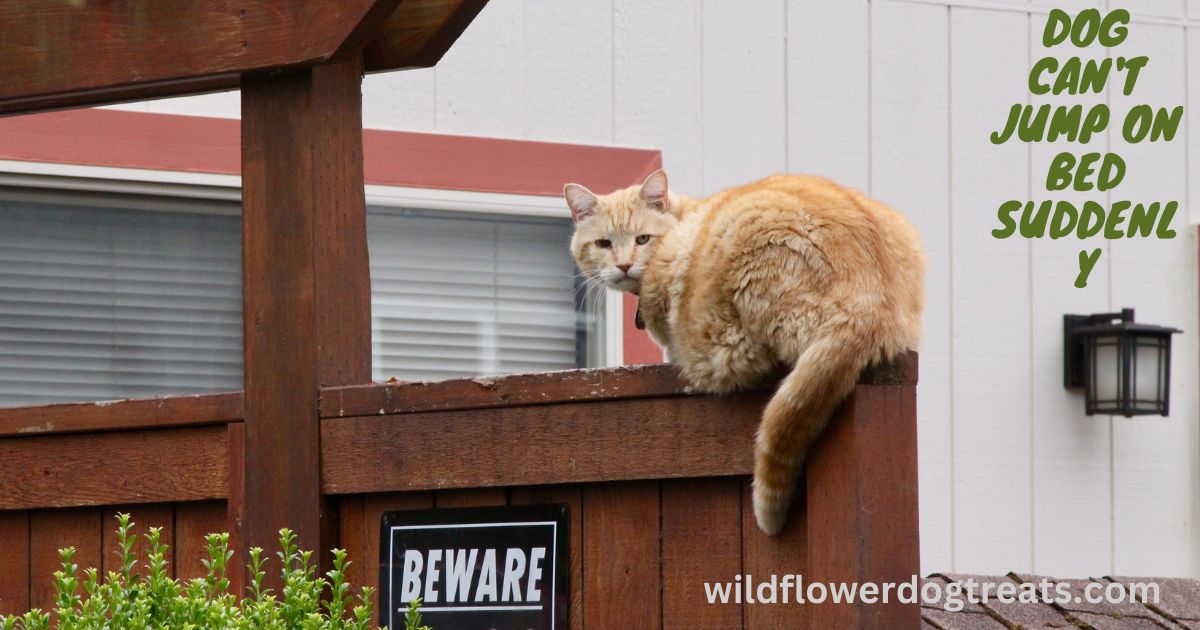If your dog suddenly can’t jump on the bed, it may be due to injury, pain, or age-related issues. This sudden change in behavior should be addressed by observing your dog’s movements and consulting with a veterinarian to determine the underlying cause.
We will explore the potential reasons why your dog may be struggling to jump on the bed and provide insights on how to best support their mobility and well-being. Your dog’s sudden inability to jump on the bed is a cause for concern and requires a close examination of their overall health and physical condition.
Understanding the possible reasons behind this change in behavior is crucial for providing appropriate care and support for your furry companion. Whether it’s due to injury, pain, or age-related factors, taking proactive measures to address the issue can help improve your dog’s quality of life.
Understanding The Physical Reasons
When your beloved furry friend suddenly shows reluctance to jump on the bed, it’s crucial to understand the underlying physical reasons. Dogs, like humans, can experience various physical ailments that may affect their ability to perform certain movements. By delving into the potential issues, you can provide the necessary care and attention to ensure your dog’s comfort and well-being.
Age-related Joint Stiffness And Arthritis
As dogs age, they can develop joint stiffness and arthritis, which can make it challenging for them to jump onto elevated surfaces. The wear and tear on their joints over time can lead to reduced flexibility and discomfort, making it difficult for them to execute the jumping motion. To alleviate their discomfort, consider providing joint supplements or implementing gentle exercise routines to help maintain their mobility and flexibility.
Muscle Or Ligament Injuries
Muscle or ligament injuries can significantly impact a dog’s ability to jump onto the bed. These injuries can be the result of overexertion, sudden movements, or accidents. Prompt veterinary attention is crucial to diagnose and treat any muscle or ligament injuries, and a period of rest and rehabilitation may be necessary to facilitate their recovery and restore their jumping ability.
Hip Dysplasia Or Other Skeletal Issues
Certain skeletal issues, such as hip dysplasia, can impede a dog’s jumping ability. These conditions can cause pain and discomfort, discouraging them from engaging in strenuous activities like jumping. Regular veterinary check-ups and appropriate management strategies, including weight management and prescribed medications, can help alleviate the symptoms and improve their mobility.
Psychological Factors That May Influence Their Behavior
Psychological factors like fear, anxiety, or territoriality could be influencing your dog’s sudden refusal to jump on the bed. Understanding and addressing these factors can help you restore your dog’s previous behavior.
Fear Or Anxiety Related To The Bed Or Bedroom Environment
Dogs can develop fear or anxiety related to the bed or bedroom environment due to various reasons. This could be the result of traumatic experiences, unfamiliar sounds or smells, or a lack of socialization with the specific area of the house. Such fears can obstruct their willingness to jump on the bed, even though they may have done so previously.
Negative Experiences Associated With Jumping On The Bed
Negative experiences such as falling off the bed, scolding, or being physically hurt while attempting to jump on the bed can create a strong aversion to repeating the action. Dogs may associate the bed with a history of negative consequences, leading them to avoid jumping on it altogether.
Lack Of Confidence Or Trust In The Bed’s Stability
Dogs may lack confidence or trust in the stability of the bed, especially if the surface is unfamiliar or has caused them discomfort in the past. This lack of trust could stem from personal experiences or innate hesitation, causing them to refrain from jumping onto the bed for their own safety.
Common Mistakes Owners Make When Addressing This Issue
When addressing the sudden inability of a dog to jump on the bed, common mistakes owners make include not considering potential medical issues, assuming behavioral causes, and using punitive training methods. It’s important to consult a veterinarian to rule out any physical ailments and employ positive reinforcement techniques for retraining.
Punishing Or Scolding The Dog
Punishing or scolding your dog when they can’t jump on the bed suddenly is a common mistake that owners make. It is important to understand that dogs are not intentionally refusing to jump on the bed. There can be various reasons why they are unable to do so, such as age-related joint issues or fear of heights.
Punishing or scolding your dog for this behavior can cause fear and anxiety, and worsen the problem. It can create a negative association with the bed and make your dog even more reluctant to jump on it in the future.
Instead of punishment, it is crucial to approach this issue with patience and understanding. By providing positive reinforcement and creating a safe and encouraging environment, you can help your dog overcome their hesitation.
Ignoring The Problem And Hoping It Will Resolve On Its Own
Ignoring the problem and hoping it will resolve on its own is another mistake that owners often make. While some dogs may eventually overcome their reluctance to jump on the bed, many will not without intervention.
By ignoring the issue, you risk prolonging your dog’s discomfort or anxiety. It is essential to address the problem proactively and provide your dog with the support they need.
Take the time to understand why your dog is hesitant to jump on the bed and work on gradually building their confidence. Ignoring the problem will only delay your dog’s progress and potentially lead to more significant issues down the road.
Forcing The Dog To Jump On The Bed
Forcing your dog to jump on the bed can be counterproductive and may even cause injury. It is important to remember that dogs have their own physical limitations and fears.
By forcing your dog to jump on the bed, you risk exacerbating their anxiety or causing physical harm. It is crucial to respect your dog’s boundaries and work at their own pace.
Instead of forcing your dog to jump, consider creating a positive association with the bed. Use treats, toys, or praise to motivate your dog and gradually build their confidence. By approaching the issue with patience and understanding, you can help your dog overcome their hesitation in a safe and supportive manner.
Steps To Help Your Dog Regain Confidence And Jump On The Bed Again
If you’ve noticed that your dog can’t jump on the bed suddenly, it might be a sign of diminished confidence. This can be a worrying situation, as jumping on the bed is often an activity that dogs enjoy. However, with the right approach, you can help your furry friend regain their confidence and get back to their favorite spot on the bed. Here are some steps you can take to achieve just that.
Consult Your Veterinarian For A Thorough Examination
Before you start any steps to address your dog’s inability to jump on the bed, it’s crucial to consult with your veterinarian. A thorough examination by a professional will help rule out any underlying health issues that might be causing the problem. By getting a clear understanding of your dog’s physical condition, you can tailor the next steps accordingly.
Consider Switching To A Lower Or More Accessible Bed
If your dog is finding it challenging to jump onto the bed, consider making the task more accessible for them. One way to do this is by switching to a lower bed that your dog can comfortably reach with a minimal jump. There are plenty of stylish bed options available that offer easy accessibility for dogs of all sizes. By providing a bed at a height suitable for your dog’s abilities, you can increase their comfort and confidence.
Gradually Reintroduce Positive Associations With The Bed
It’s important to create positive associations with the bed to boost your dog’s confidence and encourage them to jump on it again. Start by placing their favorite toys or treats near the bed, enticing them to explore the area. Allow them to approach the bed at their own pace, offering praise and rewards for any interaction with it. Gradually, you can increase their exposure to the bed, keeping the experience enjoyable and stress-free.
In addition to toys and treats, you can also reintroduce positive associations by spending quality time with your dog on the bed. This can involve grooming, cuddling, or engaging in their favorite activities. By associating the bed with positive experiences, your dog will gradually regain their confidence and feel more comfortable jumping onto it.
In conclusion, helping your dog regain confidence and jump on the bed again requires a patient and considerate approach. By consulting your veterinarian, making the bed more accessible, and reintroducing positive associations, you can support your beloved companion in overcoming this challenge. Remember, every dog is unique, so adapt these steps to suit your dog’s individual needs and abilities.
Incorporating Positive Reinforcement Training Techniques
When it comes to preventing your dog from jumping on the bed suddenly, incorporating positive reinforcement training techniques is essential. Using treats and praise to reward your dog, implementing obedience training, and providing mental and physical stimulation are effective strategies to address this behavior. By following these techniques, you can help your dog overcome the urge to jump on the bed and create a more harmonious living environment.
Use Treats And Praise To Reward Your Dog For Any Attempts To Jump On The Bed
One effective way to discourage your dog from jumping on the bed suddenly is by using treats and praise as rewards. Whenever your dog shows restraint and avoids jumping on the bed, promptly reward them with a tasty treat and positive reinforcement. Additionally, praise your dog with enthusiasm and affectionate words to reinforce the desired behavior. By consistently rewarding your dog for making the right choice, you will encourage them to maintain this behavior over time.
Implement Obedience Training To Boost Confidence And Overcome Fear
Incorporating obedience training can be a powerful tool to boost your dog’s confidence and overcome any fear-based behaviors that may lead to jumping on the bed. Utilize basic commands such as “sit” and “stay” during training sessions to establish clear boundaries and reinforce obedience. Gradually increase the difficulty of the exercises to provide a challenge for your dog and promote self-assurance. Through obedience training, your dog will learn to trust and follow your commands, reducing the likelihood of sudden bed jump attempts.
Provide Mental And Physical Stimulation To Decrease Anxiety And Stress
Another crucial factor in preventing sudden bed jumps is to ensure your dog receives adequate mental and physical stimulation. Engage your dog in activities that keep their mind and body active, such as puzzle toys, interactive games, and regular exercise. This will help decrease anxiety and stress levels, as well as alleviate any excess energy that may lead to impulsive bed jumps. By providing sufficient mental and physical stimulation, you are setting your dog up for success and promoting a calmer behavior overall.
Frequently Asked Questions For Dog Can’t Jump On Bed Suddenly
Can Dogs Suddenly Lose The Ability To Jump On The Bed?
Yes, dogs can suddenly lose the ability to jump on the bed due to various reasons such as arthritis, injury, muscle weakness, or pain. It is important to monitor your dog’s behavior and consult with a veterinarian for a proper diagnosis and treatment plan.
What Are Some Common Reasons For A Dog’s Sudden Inability To Jump?
Some common reasons for a dog’s sudden inability to jump include age-related conditions like arthritis, joint or muscle injuries, spinal problems, or underlying health issues. It’s best to seek professional advice to determine the cause and appropriate treatment for your dog.
How Can I Help My Dog If They Can’t Jump On The Bed Anymore?
To help your dog if they can’t jump on the bed anymore, consider providing them with a comfortable alternative, such as a ramp or stairs leading to the bed. You can also make sure their sleeping area is easily accessible, and consult with a veterinarian for additional guidance on managing their condition.
Conclusion
To sum up, it’s important to address sudden changes in behavior when your dog can’t jump on the bed. By taking a proactive approach, observing for signs of discomfort or pain, and seeking veterinary guidance, you can help your furry friend get back to their usual energetic self.
Remember to provide a safe and comfortable environment for your dog’s overall well-being, ensuring they can enjoy their favorite spots without any hindrance.




